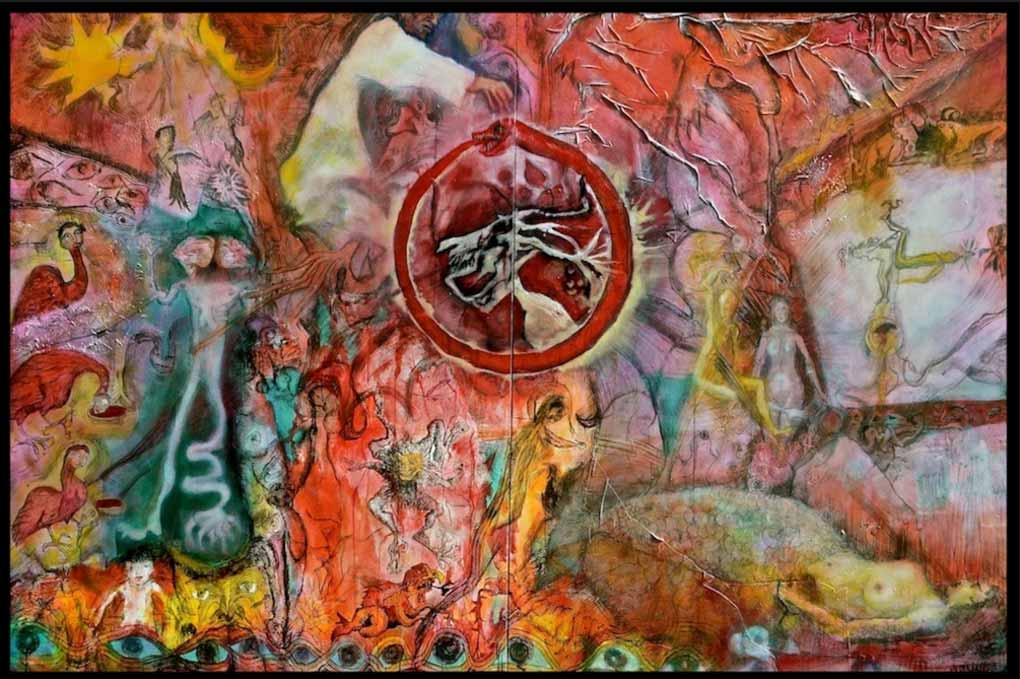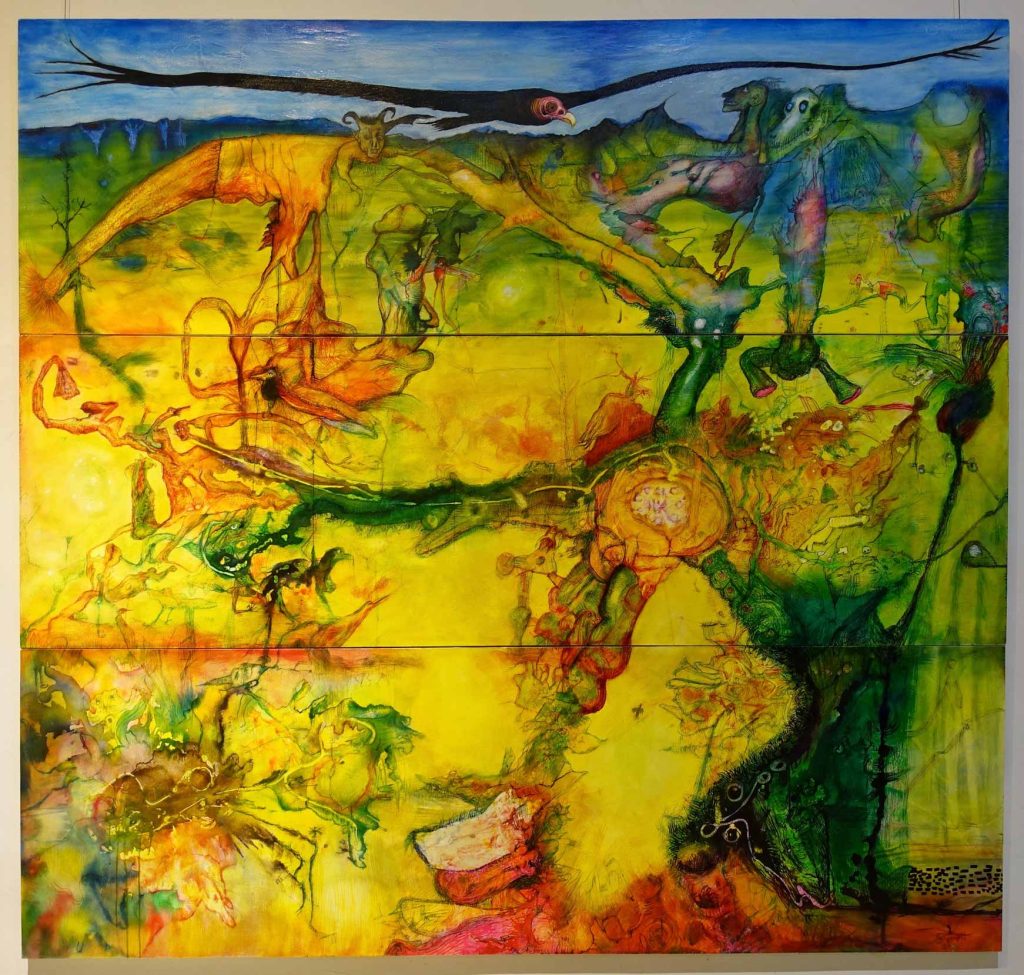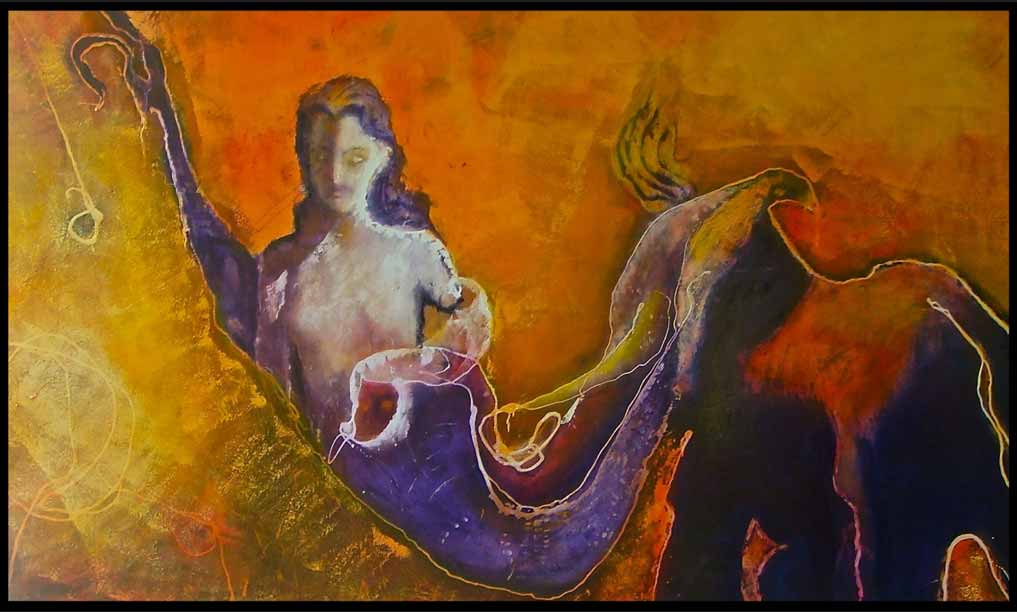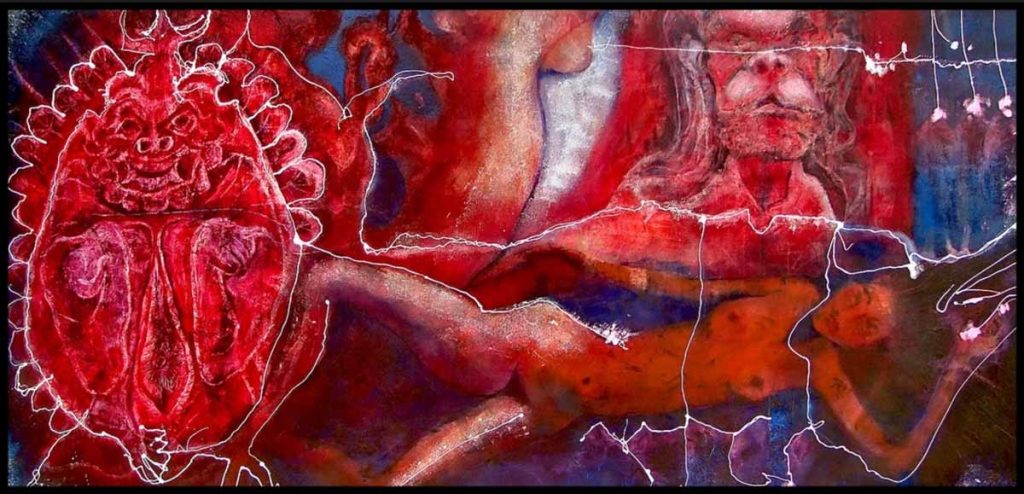Art, like the universe, is infinite. The perception and the processes of art-making may be as unique as the individual. Art ignites our senses as we interact with our inner and outer worlds. Nature’s power and beauty inform us through art. According to English artist and Ubud resident Bruce Sherratt: “A painting is a living event.”
An art scholar and international art educator with a career spanning more than forty years taking him around the globe, he has much to share about art and life. Sherratt was born in 1944 in Biddulph near Stoke-on-Trent, Southwest of Liverpool and Manchester, traditionally a coal mining and dairy farming environment. He has been painting for over 60 years. His art journey has been more profound than most. Since living in Ubud, he has honed a style he refers to as Tropical Surrealism.

Colourful, otherworldly pictures combining abstract, semi-realistic and surrealistic elements, Sherratt’s paintings are captivating and intriguing, yet not for the faint-hearted. Potent dualities come to life while invoking his inner demons, manifesting as symbolic and often unsettling forms. When engaging with his works, he offers us a key to unlocking our subconscious minds—the past and the present merge as one in vibrant works that fascinate and delight.
Tropical Surrealism and Bali go perfectly hand in hand. The rich and seductive environment, the dreamy atmosphere and exotic, vibrant culture. The Sekala/Niskala relationship of the seen and unseen worlds is a potent aspect of the island, enhancing the mythological and mysterious atmosphere. The Balinese believe that everything exists in duality. There are two opposing forces required to maintain universal balance. The philosophy of Rwa Bhineda explains this duality. Bali provides the ultimate creative ambience, allowing Sherratt to follow his heart.
Sherratt’s paintings reveal the duality and shadow aspect of the subconscious mind. I asked him to describe how the genre and Bali interact to provide the perfect stimulus.
“My attraction to Sekala/Niskala and related concepts and tropical countries and environments was established long before I came to Bali. As early as the 1970s, I was already studying and consulting the I Ching Book of Changes, primarily built upon the Yin-Yang principle of opposites. Male-Female, Dark- Light, the Visible and Invisible worlds, the individual and collective conscious and the unconscious. An awareness of Anima and Animus and the role of the Shadow and Trickster in mythology and psychoanalysis has impacted my thinking and painting for at least the past four decades both consciously and intuitively.”
“I don’t remember choosing Surrealism as the genre for me to pursue. Surrealism chose me. The majority of my life and work has occurred in tropical and subtropical areas and countries. Whatever the original spark may have been, I was driven to set up my first studio on the shores of Lake Chapala in Jalisco – the largest lake in Mexico. Since then, I have travelled, lived and worked in Africa, Venezuela, Brazil, The Philippines, Sri Lanka, Malaysia, Indonesia and now Bali. ‘Tropical Surrealism’ emerged naturally as an appropriate description for my work. Bali’s special and unique beauty is that phenomena such as the above are more evident, apparent and visible in Bali than in most other places. They manifest in the culture, art and crafts, temple architecture, rituals and ceremonies throughout the island.”
“The vibrancy and atmosphere of Bali owe much to the importance of aesthetic beauty within the unique form of Balinese Hinduism. I have always needed to create paintings with significant and relevant content. The significance can be humanistic, socio-political, spiritual or aesthetic or, as in the case of my recent picture ‘PANDEMIC 2020’, all four. To do that truthfully, with integrity, has been a predisposition and an imperative. I relish the possibility of capturing and conveying something exotic in this world and life in my paintings. To reside in a suitable locality is the highest blessing.” Sherratt once stated about his paintings: “Perhaps hope whispers in beauty and art, and the notion of metamorphosis and rebirth echoes in the harmony of colours and forms.”

Sherratt went to art school at Newcastle-under- Lyme in Staffordshire, U.K., where he took a Foundation course in art and design at the age of fifteen. He went on to Camberwell College of Art in London for two years and was awarded a degree in painting and drawing. As a young art student, he was inspired by early surrealist masters such as Max Ernst, Andre Masson and Roberto Matta. In the early 1970s, he became interested in theories and the psychology of artistic creativity, focusing on fantasy as a stimulus for developing creative/imaginative skills.
In the late 1970s, Sherratt took an advanced degree in Art Education for experienced art teachers at the University of Wales in the U.K. He researched the psychology of fantasy and art. He was invited to undertake an independent research project and thesis as an external student leading to an M.Ed (Art Education) degree. He then embarked on a two-fold career as an artist and teacher while regularly exhibiting his work in group and solo exhibitions. In addition, Sherratt became interested in comparative religions and philosophies and in the iconic spiritual scientist Rudolf Steiner’s work on colour theory, all of which profoundly affected his work both as an artist and art educator.
During May and June last year, Sherratt painted ‘PANDEMIC 2020’, a triptych of three panels in pure pigments and oil paint with the dimensions of 237 x 247cm. The Pandemic appears in the form of a huge, terrifying vulture that glides ominously across a blue sky above a rocky landscape that recalls the Staffordshire moorlands of Sherratt’s boyhood. Red and dark organic, twisted configurations inhabit the pictorial planes. Closer inspection reveals seemingly shocked faces that make eye contact with the vulture. Where there is life, side-by-side is also death. An impending cataclysm is near.


‘Pandemic 2020’ was exhibited in a short video, an online group exhibition launched by the Indonesian Ministry of Education and Culture MANFESTO VII “PANDEMI” and presented by the National Gallery of Indonesia, Jakarta. Sherratt has since donated the film and his triptych to The Potteries Museum and Art Gallery of Stoke-on-Trent, England, the region that first nurtured and inspired his creativity.
“I did not paint “about” the pandemic. I reflected and expressed the atmosphere of the time. The atmosphere of the pandemic is unavoidable for everyone, including me, and therefore for my art.” Sherratt quotes abstract pioneer painter Kandinsky when describing what is the atmosphere of a time, any time. “Not only visible actions, thoughts and feelings, with outward expression. But secret happenings, hidden plans, unspoken thoughts, hidden feelings.” Wassily Kandinsky, Concerning The Spiritual In Art, 1912.
The symbolism within ‘Pandemic 2020’ represent the darker angels of our psyche, while the colours are primarily vibrant and nurturing. ‘Pandemic 2020’ reminds us that we cannot escape our personal and collective traumas. The pain, fear and darkness we inevitably encounter must be embraced and understood. By doing this, humanity may be led upon a pathway of transformation, healing and even forgiveness.
Bruce Sherratt teaches art classes at the Bali Center of Artistic Creativity in Andong, Ubud. His paintings are on display at his Tropical Surrealism Gallery located at the same premises.
Find out more about Bruce Sherratt:
brucesherrattpaintings.com/
baliartclasses.com/









